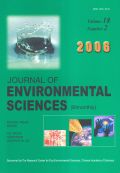Authors: SHAO, Jing-an | HUANG, Xue-xia | GAO, Ming | WEI, Chao-fu | XIE, De-ti | CAI, Zu-cong
Article Type:
Research Article
Abstract:
The terrestrial ecosystem may be either a source or a sink of CH_4 in rice paddies, depending, to a great extent, on the change of ecosystem types and land use patterns. CH_4 emission fluxes from paddy fields under 4 cultivation patterns (conventional plain culture of rice (T1), no-tillage and ridge culture of rice (T2), no-tillage and ridge culture of rice and wheat (T3), and rice-wheat rotation (T4)) were measured with the closed chamber technique
…in 1996 and 1998 in Chongqing, China. The results showed that differences existed in CH<FORMULA>_4 emission from paddy fields under these land management practices. In 1996 and 1998, CH_4 emission was 71.48% and 78.82% (T2), 65.93% and 57.18% (T3), and 61.53% and 34.22% (T4) of that in T1 during the rice growing season. During the non-rice growing season, CH_4 emission from rice fields was 76.23% in T2 and 38.69% in T1. The accumulated annual CH_4 emission in T2, T3 and T4 in 1996 decreased by 33.53%, 63.30% and 65.73%, respectively, as compared with that in T1. In 1998, the accumulated annual CH_4 emission in T1, T2, T3 and T4 was 116.96 g/m^2 , 68.44 g/m^2 , 19.70 g/m^2 and 11.80 g/m^2 , respectively. Changes in soil physical and chemical properties, in thermal and moisture conditions in the soil and in rice plant growth induced by different land use patterns were the dominant causes for the difference in CH_4 emission observed. The relative contribution of various influencing factors to CH_4 emission from paddy fields differed significantly under different land use patterns. However, the general trend was that chlorophyll content in rice leaves, air temperature and temperature at the 5 cm soil layer play a major role in CH_4 emission from paddy fields and the effects of illumination, relative humidity and water layer depth in the paddy field and CH_4 concentration in the crop canopy were relatively non-significant. Such conservative land use patterns as no-tillage and ridge culture of rice with or without rotation with wheat are thought to be beneficial to reducing CH_4 emission from paddy fields and are, therefore, recommended as a significant solution to the problems of global (climatic) change.
Show more
Keywords: land use pattern, microcosmic cultivation scale, fluxes of CH_4 emission, paddy field
Citation: Journal of Environmental Sciences,
vol. 17, no. 4, pp. 691-698, 2005
Price: EUR 27.50





